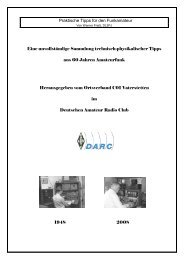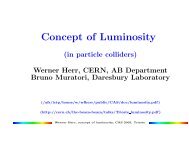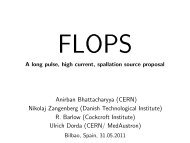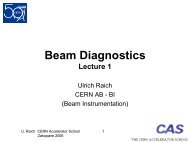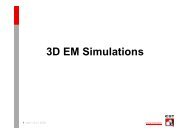mode - CERN Accelerator School
mode - CERN Accelerator School
mode - CERN Accelerator School
You also want an ePaper? Increase the reach of your titles
YUMPU automatically turns print PDFs into web optimized ePapers that Google loves.
<strong>mode</strong> 0<br />
<strong>mode</strong> π/2<br />
<strong>mode</strong> 2π/3<br />
<strong>mode</strong> π<br />
More on standing wave<br />
structures<br />
E<br />
1<br />
0.8<br />
0.6<br />
0.4<br />
0.2<br />
0<br />
0 50 100150 200 250<br />
1.5<br />
1<br />
0.5<br />
0<br />
-0.5 0<br />
-1<br />
-1.5<br />
50 100150 200 250<br />
1.5<br />
1<br />
0.5<br />
0<br />
-0.5 0 50 100 150 200 250<br />
-1<br />
-1.5<br />
1.5<br />
1<br />
0.5<br />
0<br />
-0.5 0 50 100 150 200 250<br />
Standing wave <strong>mode</strong>s are named from the<br />
phase difference between adjacent cells: in<br />
the example above, <strong>mode</strong> 0, π/2, 2π/3, π.<br />
In standing wave structures, cell length can<br />
be matched to the particle velocity !<br />
-1<br />
-1.5<br />
z<br />
→ These STANDING WAVE MODES<br />
are generated by the sum of 2<br />
traveling waves in opposite<br />
directions, adding always in the same<br />
way in the different cells.<br />
→ For acceleration, the particles must<br />
be in phase with the E-field on axis.<br />
We have already seen the π <strong>mode</strong>:<br />
synchronism condition for cell length<br />
l = βλ/2.<br />
→ Standing wave structures can be<br />
used for any β (→ ions and<br />
electrons) and can follow the<br />
increase in β of the ions.<br />
Synchronism conditions:<br />
0-<strong>mode</strong> : l = βλ<br />
π/2 <strong>mode</strong>: 2 l = βλ/2<br />
π <strong>mode</strong>: l = βλ/2<br />
13



